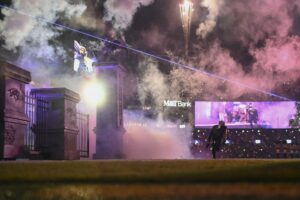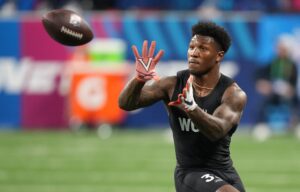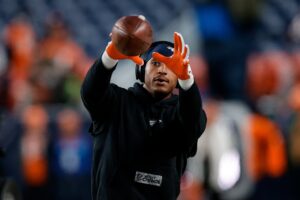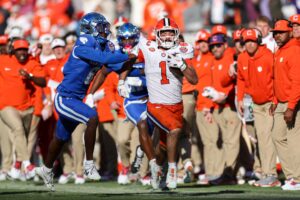Isaac Bruce is a finalist for the Hall of Fame this year, and while he doesn’t deserve to go in as a part of this year’s class, he certainly deserves to be inducted at some point in the future.
Pro Football Hall of Fame: The Case for Isaac Bruce
Breaking Down the Finalists
The Hall of Fame selection committee will narrow the remaining 15 finalists to 10, and then the final five candidates. Those final five must receive at least 80 percent of the vote for enshrinement to the Hall of Fame, and the results will be announced on February 2.
The maximum that can be inducted from that group of 15 this year is the final five candidates, but there is no minimum that must be inducted. Besides Bruce, the finalists are Steve Atwater, Champ Bailey, Tony Boselli, Alan Faneca, Tony Gonzalez, Steve Hutchinson, Edgerrin James, Ty Law, John Lynch, Kevin Mawae, Ed Reed, Richard Seymour, as well as coaches Don Coryell and Tom Flores.
Bruce retired after the 2009 season, so he has been eligible for Hall of Fame induction since 2015 after waiting the required six years. It took Bruce a couple years to make it this far in the process, though. He has been a finalist for three consecutive seasons now. This is his fifth year of eligibility, and he did not become a finalist in his first two seasons in which he was eligible for induction. Of the 13 players who are finalists, Bruce is tied for fourth in longest time being eligible with James, Law, and Mawae.
The five players out of these 15 finalists who deserve to be inducted this year are Gonzalez, Faneca, Bailey, Reed, and Hutchinson. Faneca and Gonzalez lead the group with six AP All-Pro First Team appearances apiece, and Reed and Hutchinson are tied for third with five AP All-Pro First Team appearances each.
Bailey, Boselli, Mawae, and Seymour all have three AP All-Pro First Team appearances. But what sets Bailey apart from those other three players are his Pro Bowl appearances. Bailey made 12 Pro Bowls in his career, which is the second most of any of the 13 players, trailing only the 14 made by Gonzalez. Pro Bowls aren’t as prestigious as AP All-Pro First teams, but they really demonstrate skill, influence, and popularity within the league’s landscape. Bailey having so many illustrates his longevity as one of the elite cornerbacks in the league during his career.
Lynch has nine Pro Bowl selections, which ranks fourth amongst these 13 players, but only made two AP All-Pro First Teams in his career. Lynch is forced to take a backseat to other players within their group who proved to more often be given the distinction of being the premier player at their position.
Boselli is most impeded by his short career relative to the other finalists, as injuries forced him to retire after playing in just seven total seasons. Atwater is in a similar situation to Lynch, being an AP All-Pro First Team selection just twice in his career, but making a lot of Pro Bowls. The three players whose cases for the Hall of Fame rely more on statistics at their positions than lofty All-Pro and Pro Bowl appearances are Law, James, and Bruce.
Law is tied for 24th in league history in interceptions. He has the same number of career interceptions as the legendary Deion Sanders at 53, and one more than Bailey. Of the 22 players who have as much or more career interceptions than Law and have been eligible for the Hall of Fame before this season, 13 have made the Hall of Fame.
James has more career rushing yards than Marcus Allen and more total touchdowns in his career than Tony Dorsett. He is 13th all-time in career rushing yards, and all 10 players ahead of him on that list who are eligible for the Hall of Fame have been elected.
Like Law and James, the case for Bruce is based more on his stats at his position relative to those of other ex-players who have made the Hall of Fame. None of those three deserve to be elected to the Hall of Fame this year in particular, but they all deserve to go in eventually. All 15 of these finalists deserve to make the Hall of Fame someday, but Gonzalez, Faneca, Bailey, Reed, and Hutchinson are the ones who deserve to go in this year.
In terms of the coaches amongst these finalists, both Coryell and Flores deserve to be inducted eventually, but shouldn’t go in this year. When looking at other coaches who are not yet in the Hall of Fame, it becomes clear that there’s not much urgency to elect Coryell or Flores before those other guys.
Coryell pioneered the aerial offensive attack that foreshadowed what the league would look like decades after his retirement, and Flores was one of only 13 coaches who has won at least two Super Bowls. They’re both legendary coaches, but there are numerous other coaches that should be elected before either of those two.
Mike Shanahan has as many Super Bowls as Flores and a higher career winning percentage in the regular season, but he isn’t in the Hall of Fame. Coryell never even reached a Super Bowl, let alone won one, and has a lower career regular season winning percentage than Shanahan, Mike Holmgren, Marty Schottenheimer, Bill Cowher, and George Seifert.
Like Coryell, Schottenheimer never reached a Super Bowl, but he is one of just seven coaches in league history to win at least 200 regular season games. Seifert has two Super Bowls, and Shanahan, Holmgren, and Cowher all have a Super Bowl plus a higher career regular season winning percentages than Coryell.
How Bruce Compares to Other Hall of Fame Receivers
Since wide receivers actually score touchdowns, they are one of the “glamorous” positions out on the field relative to other positions. While many guys out on the field do the grunt work that isn’t as easily appreciated or recorded, wide receivers can simply point to more obvious metrics to prove worth. While factors like hands, route-running ability, and acceleration can be used to differentiate legendary receivers, the most objective judgment is stats like receptions, yards, and touchdowns.
When looking at the career leaderboards in those stats, it is undeniable that Bruce is logically the next receiver who deserves induction to the Hall of Fame. The numbers speak for themselves. Bruce is fifth all-time in receiving yards, 12th all-time in receiving touchdowns, and 13th all-time in receptions.
Every player who has been eligible for the Hall of Fame before this year that has more catches, receiving yards, or receiving touchdowns has been inducted into the Hall of Fame. Bruce has more career catches than Randy Moss, more receiving yards than Tim Brown, and more receiving touchdowns than Andre Reed.
Bruce is very comparable to other wide receivers who have already been inducted, and it’s really just a matter of how long he’ll have to wait to be inducted. There are a lot of receivers with similar career stats that had to wait their turn for a handful of years before being enshrined. Cris Carter had to wait six years before being elected. It took Brown six years of eligibility to be elected. It took Reed nine years of eligibility to be elected. Bruce is getting in eventually, but he’s likely going to have to be patient with the process before earning much-deserved induction.
Bruce Was an Incredible Receiver for a Long Time
There weren’t many seasons in which Bruce was definitively one of the top two or three receivers in football, but he was consistently putting up 1,000-yard seasons for a long time. During the Rams Greatest Show on Turf era, Bruce connected with Kurt Warner for some extremely memorable plays, including the game-winning touchdown with under two minutes remaining in their Super Bowl victory over the Tennessee Titans. It was a truly legendary offense, and alongside guys like Warner, Marshall Faulk, and Torry Holt, the Rams of the late 1990s and early 2000s featured an explosive offensive attack the likes of which the league had never really seen before.
Bruce was originally going to attend Purdue, but he wasn’t able to meet the school’s standards regarding SAT scores. He opted to go the community college route instead, enrolling in West Los Angeles College and Santa Monica College before transferring from there to Memphis, which was then known as Memphis State.
Bruce was drafted by the Los Angeles Rams in the second round of the 1994 NFL Draft, being selected at number 33 by a team that was nearby during his community college stint. Bruce was named the Rams best rookie for that 1994 season, and that was the only season he played in Los Angeles before the team moved to St. Louis for the 1995 season.
It was in his second year that he asserted himself as one of the best receivers in the league, finishing with 119 receptions, 1,718 receiving yards, and 13 touchdowns. At the time, that was the second most receiving yardage ever in a single season, only surpassed by Jerry Rice that same year. It still ranks as the fifth highest single-season total in league history all these years later, made all the more remarkable that it occurred before passing statistics really exploded. During that 1995 season, Bruce became the first player in league history to record three straight games of at least 170 receiving yards.
His stats took a bit of a dip in 1996 compared to that legendary 1995 season, but he still finished with 84 catches, 1,338 yards, and seven touchdowns. 1996 would feature only the third highest total of receiving yards in a single season for Bruce, but it was the only year in which he led the NFL in receiving yards.
Bruce never made an AP All-Pro First Team in his career, and never being recognized as one of the two best receivers in any season is the biggest factor that works against Bruce in assessing his Hall of Fame qualifications. What’s odd is that Bruce’s legendary 1995 season wasn’t even rewarded with a Pro Bowl selection, as his four Pro Bowls all came in seasons with less impressive statistical output.
Bruce was hampered by injuries in 1997 and 1998, but he was healthy for 1999 and served as the top receiver on a Super Bowl-winning squad. Along with scoring the game-winning touchdown in that Super Bowl victory, Bruce hauled in six catches for 162 yards in that game.
Holt emerged as an elite receiver in his own right in 2000, and he and Bruce both finished that season with over 1,400 receiving yards. At the time, they were just the second receiving duo in league history to accomplish that, following Herman Moore and Brett Perriman in 1995.
The Rams again made the Super Bowl during the 2001 season, but this time lost to the New England Patriots on a last-second field goal by Adam Vinatieri. When Rice retired in 2005, Bruce became the active leader in receiving yards, although he was eventually passed that year by Marvin Harrison after Bruce suffered a foot injury and missed five games. Bruce would eventually pass Harrison again in that same category during the 2007 season, which also proved to be the final season he played with the Rams.
He spent the last two seasons of his career with the San Francisco 49ers, and in the summer of 2010, he was traded back to the Rams so he could officially retire with them. By the time he retired, the only player in league history who accumulated more receiving yards in their career than Bruce was Rice.
Bruce Helps Make the Case for Holt for Hall of Fame
Bruce led the Rams in receiving yards just three times in his 14 seasons spent with the team, which might be more of a testament to how good Holt was at his peak. Holt led the Rams in receiving yards in every season from 2000-2008, and all but the 2008 season was spent playing alongside Bruce.
Bruce had five separate 1,000-yard seasons during that stretch Holt was leading the team in receiving, and there’s a real case to be made that they’re the greatest receiving duo of all time. Bruce played in 39 more games with the Rams compared to Holt, and that’s why he became the franchise leader in major receiving statistics.
Bruce is the franchise leader in catches, yards, and touchdowns, although Holt averaged more of each of those stats per game in his Rams career. Once Bruce gets into the Hall of Fame, it should open the door for Holt to also be enshrined at some point in the future.
Bruce Warrants Hall of Fame Induction Eventually
Based on his extremely impressive career totals at the position, Bruce needs to be the next wide receiver who gets elected into the Hall of Fame. It shouldn’t happen this year, but Bruce deserves a Hall of Fame nod at some point in the future given his status as one of the greatest receivers to ever play in the league.
As one of the most dynamic weapons in a historically potent offense, Bruce has a special place within the lore of football. Bruce has the stats to warrant inclusion to the Hall of Fame, and while he shouldn’t get in this season, his addition to the Hall of Fame someday will be to the benefit of all those who appreciate the history of this great game.






